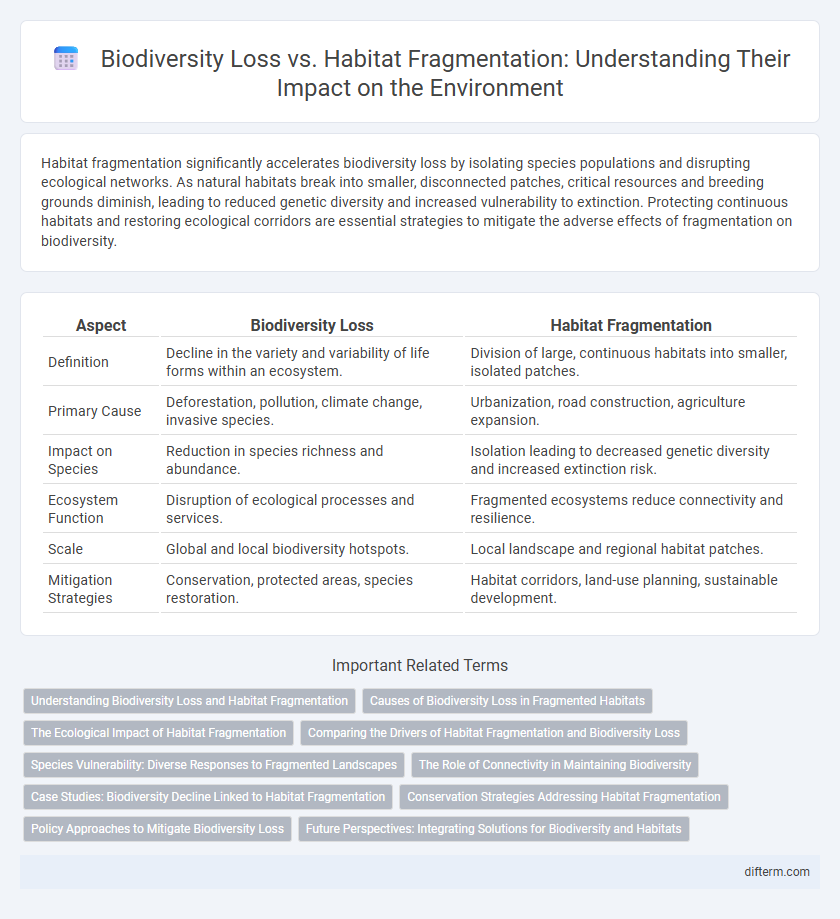Habitat fragmentation significantly accelerates biodiversity loss by isolating species populations and disrupting ecological networks. As natural habitats break into smaller, disconnected patches, critical resources and breeding grounds diminish, leading to reduced genetic diversity and increased vulnerability to extinction. Protecting continuous habitats and restoring ecological corridors are essential strategies to mitigate the adverse effects of fragmentation on biodiversity.
Table of Comparison
| Aspect | Biodiversity Loss | Habitat Fragmentation |
|---|---|---|
| Definition | Decline in the variety and variability of life forms within an ecosystem. | Division of large, continuous habitats into smaller, isolated patches. |
| Primary Cause | Deforestation, pollution, climate change, invasive species. | Urbanization, road construction, agriculture expansion. |
| Impact on Species | Reduction in species richness and abundance. | Isolation leading to decreased genetic diversity and increased extinction risk. |
| Ecosystem Function | Disruption of ecological processes and services. | Fragmented ecosystems reduce connectivity and resilience. |
| Scale | Global and local biodiversity hotspots. | Local landscape and regional habitat patches. |
| Mitigation Strategies | Conservation, protected areas, species restoration. | Habitat corridors, land-use planning, sustainable development. |
Understanding Biodiversity Loss and Habitat Fragmentation
Biodiversity loss results from species extinction and population declines caused by habitat fragmentation, which breaks ecosystems into smaller, isolated patches. Habitat fragmentation disrupts animal movement and plant dispersal, reducing genetic diversity and ecosystem resilience. Understanding the link between fragmentation and biodiversity loss is crucial for developing effective conservation strategies and preserving ecological balance.
Causes of Biodiversity Loss in Fragmented Habitats
Habitat fragmentation, driven primarily by urban expansion, agriculture, and infrastructure development, disrupts ecosystem connectivity, leading to isolated wildlife populations and reduced genetic diversity. This isolation increases species vulnerability to environmental changes, predation, and disease, accelerating biodiversity loss. Fragmented habitats also hinder species migration and reproduction, further exacerbating the decline of endemic flora and fauna.
The Ecological Impact of Habitat Fragmentation
Habitat fragmentation drastically reduces biodiversity by isolating species populations, leading to decreased genetic diversity and increased vulnerability to extinction. Fragmented habitats disrupt ecological processes such as pollination, seed dispersal, and predator-prey interactions, impairing ecosystem resilience and function. The loss of habitat connectivity compromises large mammal migration routes and bird nesting sites, intensifying species decline and ecosystem imbalance.
Comparing the Drivers of Habitat Fragmentation and Biodiversity Loss
Habitat fragmentation primarily results from land-use changes such as agriculture expansion, urban development, and infrastructure projects, which isolate ecosystems and reduce habitat connectivity. Biodiversity loss is driven by multiple factors including habitat fragmentation, climate change, pollution, invasive species, and overexploitation of resources. While habitat fragmentation directly alters spatial habitat structure affecting species distribution, biodiversity loss encompasses broader ecological disruptions leading to species extinction and reduced ecosystem resilience.
Species Vulnerability: Diverse Responses to Fragmented Landscapes
Species vulnerability to habitat fragmentation varies significantly due to differences in ecological traits, mobility, and reproductive strategies. Fragmented landscapes disrupt migration routes, limit gene flow, and reduce population sizes, intensifying the risk of local extinctions and accelerating biodiversity loss. Understanding species-specific responses to these altered habitats is crucial for developing targeted conservation strategies and mitigating further declines.
The Role of Connectivity in Maintaining Biodiversity
Connectivity plays a critical role in counteracting biodiversity loss caused by habitat fragmentation by facilitating species movement and gene flow across isolated patches. Ecological corridors and landscape linkages enhance habitat connectivity, supporting population viability and ecosystem resilience. Maintaining connectivity ensures stable biodiversity, enabling species to adapt to environmental changes and reducing extinction risks.
Case Studies: Biodiversity Decline Linked to Habitat Fragmentation
Biodiversity decline is often directly correlated with habitat fragmentation, as evidenced by case studies in the Amazon rainforest, where road construction has isolated species populations and reduced genetic diversity. In the tropical forests of Borneo, fragmentation has led to critical habitat loss for orangutans, causing population decreases and heightened extinction risk. Similarly, fragmented habitats in the North American prairies disrupt migration routes for pollinators, undermining ecosystem resilience and species survival.
Conservation Strategies Addressing Habitat Fragmentation
Effective conservation strategies targeting habitat fragmentation emphasize the restoration and connectivity of natural landscapes through wildlife corridors and buffer zones to support species migration and genetic diversity. Implementing land-use planning that limits infrastructure development in critical habitats mitigates further fragmentation and preserves ecosystem integrity. Community-based conservation initiatives and habitat protection laws enhance resilience against biodiversity loss by maintaining ecological networks essential for species survival.
Policy Approaches to Mitigate Biodiversity Loss
Effective policy approaches to mitigate biodiversity loss prioritize addressing habitat fragmentation by enforcing stricter land-use regulations and establishing ecological corridors that connect isolated habitats, enhancing species mobility and genetic diversity. Integrating biodiversity considerations into urban planning and agricultural policies reduces habitat destruction and supports ecosystem resilience. Incentivizing conservation through funding mechanisms and community engagement promotes sustainable land management practices crucial for preserving biodiversity.
Future Perspectives: Integrating Solutions for Biodiversity and Habitats
Future perspectives on biodiversity loss emphasize the integration of habitat restoration and connectivity strategies to counteract fragmentation impacts. Implementing green corridors and protected area networks enhances species migration and genetic diversity, fostering ecosystem resilience. Advances in spatial planning and remote sensing technologies enable targeted conservation actions that simultaneously address habitat fragmentation and biodiversity decline.
biodiversity loss vs habitat fragmentation Infographic

 difterm.com
difterm.com